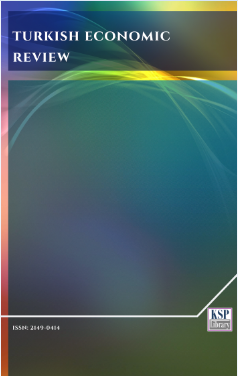Corruption Forms and Heath Care Provision in Douala Metropolis Public Hospitals of Cameroon
Abstract
Abstract. This study analyzes and highlights the most practised forms of corruption in public hospitals of Douala metropolis in Cameroon, namely corruption with theft and that without theft. The results of our analyzes show a predominance of the form without theft, this regardless of the hospital, and this allowed us to classify hospitals based on the dominant form. It appears that the General and Deido Hospitals are health facilities where corruption without theft is the least and the most practiced respectively, while the Cité des Palmiers and New Bell hospitals are those where corruption with theft is the least and the most practiced. An estimate through odds ratios revealed for instance that the odds would be about 5.46 times higher that the form without theft is not practiced at the General hospital compared to other hospitals, and about 11.11 times that it is practiced at Deido hospital compared to all hospitals.
Keywords. Corruption forms, Health system, Odds ratio, Cameroon.
JEL. I10, I14, I15.
Keywords
References
Akumjili, D. (2006). The fight against counterfeit drugs in Nigeria, Rapport Mondial 2006 de Transparency, International sur la corruption.
Allen, S.G. (1981). An empirical model of work attendance, Review of Economics and Statistics, 63(1), 77-87. doi. 10.2307/1924220
Baillargeon, G. (1989). Probabilités, statistiques et techniques de régression. Les Editions SMG.
Banque Mondiale, (2004). Rapport sur le développement dans le monde: Mettre les services de base à la portée des pauvres. Banque Mondiale.
Cartier-Bresson, J. (1995). Les réseaux de la corruption et la stratégie des “3S”, sleep, silence, smile, dans Borghi et Meyer - Bisch, la corruption, Ed. Universitaire de Fribourg.
Chaudhury, N., Hammer, J., Kremer, M., Muralidharan, K., & Rogers, F.H., (2006). Missing in action: Teachers and health workers in developing countries, Journal of Economic Perspectives, 20(1), 91-116. doi. 10.1257/089533006776526058
Ferinho, P., Omar M.C., Fernandes, M., Blaise, P., Bugalho, A.M., & Lerberghe, M.V. (2004). Pilfering for survival: How health workers use access to drugs as a coping mechanism, Human Resources for Health, 2(4), 1-6. doi. 10.1186/1478-4491-2-4
Garcia-Prado, A., & Chawla, M. (2006). The impact of hospital management reforms on absenteeism in Costa Rica, Health Policy and Planning, 21(2), 91-100. doi. 10.1093/heapol/czj015
Gupta, S., Davoodi, H., & Tiongson, E. (2002). Corruption and the provision of health care and educative services, IMF Working Paper, No.wp/00/116. [Retrievd from].
Institut National de la statistique, (2001). Perception de la gouvernance et de l’intégrité au Cameroun, Cameroun.
Johnston, M. (1986). The political consequence of corruption: A reassessment, Comparative Politics, 18(4), 459-477. doi. 10.2307/421694
Kaufman, D., & Wei, S. (1999). Does greas money spend up the wheels of commerce?, NBER Working Paper No.7093. doi. 10.3386/w7093
Klitgaard, R. (1989). Combattre la corruption, Nouveaux Horizons, Manille – Philippines.
Lewis, M. (2000). Who is paying for health care in Eastern Europe and Central Asia ?, Département du développement humain, Région Europe et Asie Centrale. Washington DC, Banque Mondiale. [Retrieved from].
Lui, F. (1985). An equilibrium queening model of bribery, Journal of Political Economy, 93(4). 760-81. doi. 10.1086/261329
Maestad, O., & Mwisongo, A. (2007). Informal payments and the quality of health care in Tanzania: Results from qualitative de travail du CMI WP.2007:5, Bergen: Chr, Michelsen Institute.
Mauro, P. (2002). Corruption and the composition of government expenditure. G.T. Abed & S. Gupta, (Eds.), Governance, Corruption, Economic Performance. International Monetary Fund.
Médard, J.F. (2002). La corruption en Afrique Francophone” in Transparency International, Combattre la corruption, Enjeux et perspectives, (pp.9-34), Paris, Karthrala.
Murphy, K., Shleifer, A., & Vishny, R.W. (1993). Why is rent-secking so costly to growth?, American Economic Review, 83(2), 409-414.
Murphy, K., Shleifer, A., & Vishny, R.W. (1991). The allocation of talent: implication for growth, Quaterly Journal of Economics, 106(2), 503-30. doi. 10.2307/2937945
OMS, (1998). Ethical criteria for Medicinal Drug Promotion. Genève, OMS.
OMS, (2008). Essential Medecines, Rapport Bimensuel, 2006-2007.
Organisation Mondiale de la santé, (2004). Who Medecines Strategy: Countries at the core, 2004-2007. [Retrieved from].
PNUD, (2011). Lutte contre la corruption dans le secteur de la santé: Méthodes, outils et bonnes pratiques, Octobre, New York NY 10017. [Retrieved from].
Rose-Ackerman, S. (1978). Corruption: A study in Political Economy, Academic Press, New York.
Rose-Ackerman, S. (1998). Stratégies de reformes anticorruption, mondes en développement, Tome, 26. 41-540. [Retrieved from].
Rumyantseva, N. (2005). Taxonomy of corruption in Higher Education, Peabody Journal of Education, 80(1). 81-92.
Shapiro, C., & Stiglitz, J. (1984). Equilibrium unemployment as a worker discipline device, American Economic Review, 74(3), 433-444.
Shleifer, A., & Vishny, R.W. (1993). Corruption, Quarterly Journal of Economics, 108(3), 599-617. doi. 10.2307/2118402
Szende, A., & Culyer, A.J. (2006). The inequality of Informal payments for health care: The case of Hungary, Health Policy, 75(3), 262-271. doi. 10.1016/j.healthpol.2005.04.001
Vian, T. (2002). Corruption and health Sector, U.S. Agency for International Development (USAID) and Management Systems International (MSI)
Vian, T. (2006). Corruption in hospital, administration. Dans le Rapport Mondial sur la corruption dans le secteur de la santé. Transparency International
Vian, T. (2007). Review of corruption in the health sector: Theory, methods and invention, Health Policy and Planning, 23(2), 83-94. doi. 10.1093/heapol/czm048
Winston, G.C. (1979). The appeal of inappropriate technologies: Self-inflicted wages, ethnic pride and corruption, World Development, 7(8-9), 835-845. doi. 10.1016/0305-750X(79)90041-X
Yamb, B., & Bayemi, O.V. (2015). An empirical evaluation of the characteristics of the victims of corruption in public hospitals in Cameroon: The case of Douala metropolis, African Journal of Social Sciences, 5(2), 58-76.
Yamb, B., & Bayemi, O.V. (2016). Bribery in Cameroonian public hospitals: Who pays and how much?, Asian journal of Social Sciences and Management Studies, 3(1), 7-17. doi. 10.20448/journal.500/2016.3.1/500.1.7.17
Yamb, B., & Bikoue, M. (2016). The determinants of moonlighting among state universities lecturers in Cameroon: An evidence from a log-linear model, Research in Applied Economics, 8(3), 19-48. doi. 10.5296/rae.v8i3.8795DOI: http://dx.doi.org/10.1453/ter.v4i1.1206
Refbacks
- There are currently no refbacks.
.......................................................................................................................................................................................................................................................................................................................................
Turkish Economic Review - Turk. Econ. Rev. - TER - www.kspjournals.org
ISSN: 2149-0414
Editor: [email protected] Secretarial: [email protected] Istanbul - Turkey.
Copyright © KSP Library




